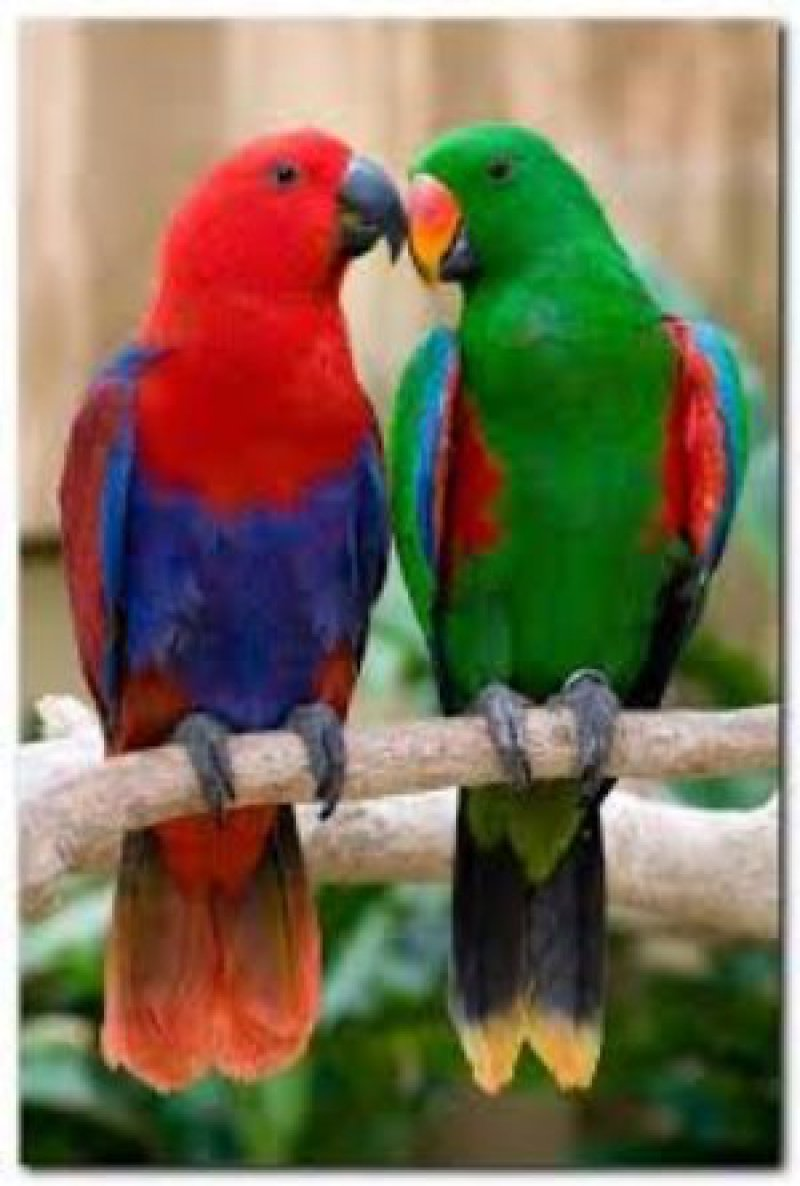Red-Sided Eclectus

Description
The eclectus parrot (Eclectus roratus) is a parrot native to the Solomon Islands, Sumba, New Guinea and nearby islands, northeastern Australia, and the Maluku Islands (Moluccas). It is unusual in the parrot family for its extreme sexual dimorphism of the colours of the plumage; the male having a mostly bright emerald green plumage and the female a mostly bright red and purple/blue plumage. Joseph Forshaw, in his book Parrots of the World, noted that the first European ornithologists to see eclectus parrots thought they were of two distinct species. Large populations of this parrot remain, and they are sometimes considered pests for eating fruit off trees. Some populations restricted to relatively small islands are comparably rare. Their bright feathers are also used by native tribespeople in New Guinea as decorations.
The eclectus parrot is unusual in the parrot family for its marked visible light sexual dimorphism in the colours of the plumage. A stocky short-tailed parrot, it measures around 35 cm (14 in) in length. The male is mostly bright green with a yellow-tinge on the head. It has blue primaries, and red flanks and underwing coverts. Its tail is edged with a narrow band of creamy yellow, and is dark grey edged with creamy yellow underneath, and the tail feathers are green centrally and more blue as they get towards the edges. The grand eclectus female is mostly bright red with a darker hue on the back and wings. The mantle and underwing coverts darken to a more purple in colour, and the wing is edged with a mauve-blue. The tail is edged with yellowish-orange above, and is more orange tipped with yellow underneath. The upper mandible of the adult male is orange at the base fading to a yellow towards the tip, and the lower mandible is black. The beak of the adult female is all black. Adults have yellow to orange irises and juveniles have dark brown to black irises. The upper mandible of both male and female juveniles are brown at the base fading to yellow towards the biting edges and the tip.[5]
The above description is for the nominate race. The abdomen and nape of the females are blue in most subspecies, purple abdomen and nape in the subspecies (roratus) and lavender abdomen and nape in the (vosmaeri) subspecies from the north and central Maluku Islands, and red abdomen and nape in the subspecies from Sumba and Tanimbar Islands (cornelia and riedeli). Females of two subspecies have a wide band of yellow on the tail tip, riedeli and vosmaeri which also have yellow undertail coverts. The female vosmaeri displays the brightest red of all the subspecies, both on the head and body.
Scientific Name
Eclectus Roratus Polychloros
Country Of Origin
Size
Life Expectancy
Noise Level
Low
Talk / Trick Ability
Moderate; can learn to talk if socialized early.
Characteristics
The red-sided Eclectus often enjoys asserting its personality while interacting with its owner. Expect a curious and intelligent pet bird that needs stimulating toys and lots of socialization. Because the red-sided Eclectus parrots are known to form a strong bond with their owners, they are often considered sweet and affectionate pet birds.
While red-sided Eclectus parrots are content with entertaining themselves, they need human interaction on a regular basis as well. Female red-sided Eclectus parrots have heavier, more rounded bodies while males are slimmer. Female red-sided Eclectus are mostly red and have purple-blue chest feathers. Males are shades of green with some blue and yellow coloration, depending on the species. Mature female red-sided Eclectus parrots have an all-black beak while males have red, yellow and orange beaks.
Behavior / Health Concerns
Many aviculturists agree that supplemental vitamins added to an Eclectus’s diet can contribute to “toe tapping,” a condition where the parrot’s toes repetitively extend and contract. Ask your avian veterinarian before adding supplements or manufactured foods to your pet Eclectus’s diet.
Eclectus parrots are susceptible to feather picking, respiratory infections and excessive chewing. They need higher vitamin-A than other parrots. Vitamin-A-enriched foods include carrots, squash, broccoli, kale and cooked sweet potatoes. Cases of feather picking in this pet bird are often caused by malnutrition and vitamin-A deficiency.
Eclectus parrots enjoy spending time with their owners, but these pet birds also like some quiet time alone. Eclectus owners should be prepared for a pet parrot whose personality will change through time. Provide Eclectus parrots with toys made of softer wood because their beaks are not as powerful as those of other parrots. Eclectus parrots enjoy wrapping their toes around their toys, so supervise your bird for any potential safety hazards.